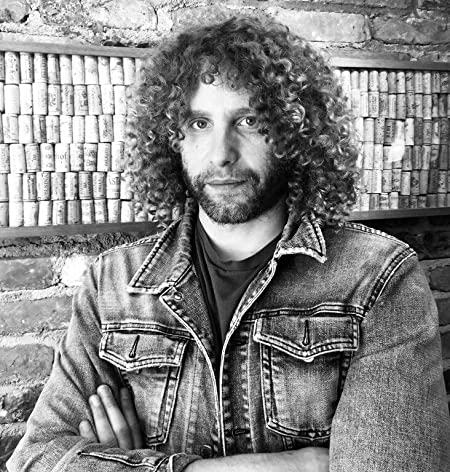Slash Reveals the Method Behind His Riff-Writing Madness
The top-hatted one himself discusses the new gear he’s been using onstage, and what’s on the horizon for the Conspirators and Guns N’ Roses.
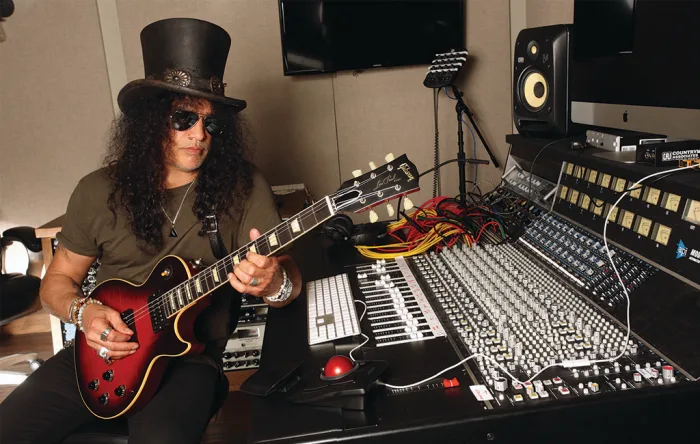
Slash has spent the last several years traveling the globe with Guns N’ Roses on their blockbuster Not in This Lifetime stadium outing, which finds the guitarist and bassist Duff McKagan reunited with frontman Axl Rose for the first time in more than two decades.
Somewhere in the midst of it all, he also managed to write and record a third studio record, Living the Dream (Snakepit), with his own band, Slash featuring Myles Kennedy and the Conspirators, as well as launch a world tour in support of the effort. When he gets on the phone with Guitar Player, he’s somewhere in Brazil, in the midst of what he calls, perhaps not surprisingly, “the most extensive South American tour I’ve ever done.”
Of course, Slash can stay so busy onstage and in the studio because so many people want to see and hear him play. And the reason for that, to follow a thread, is due to the fact that he’s had a large hand in writing, recording and performing some of the greatest and most enduring hard rock music of the past 30-plus years. That includes everything from GN’R classics like “Welcome to the Jungle,” “Sweet Child O’ Mine” and “Rocket Queen” to Conspirators favorites like “Anastasia” and the latest Living the Dream single, “Boulevard of Broken Hearts.”
With that in mind, who better to sit down with Guitar Player to discuss the ins and outs of songwriting, riff making and the music creative process than the top-hatted one himself? In addition, Slash gave us a glimpse of his brand-new L.A.-area studio, the Snakepit, showed us the new gear he’s been using onstage, and talked about what’s on the horizon for the Conspirators and Guns N’ Roses.
As for what we’ll hear, and when? The jury’s still out. “When it comes to writing,” Slash says, “I do not like to be on any kind of stringent schedule. So we’ll see.”
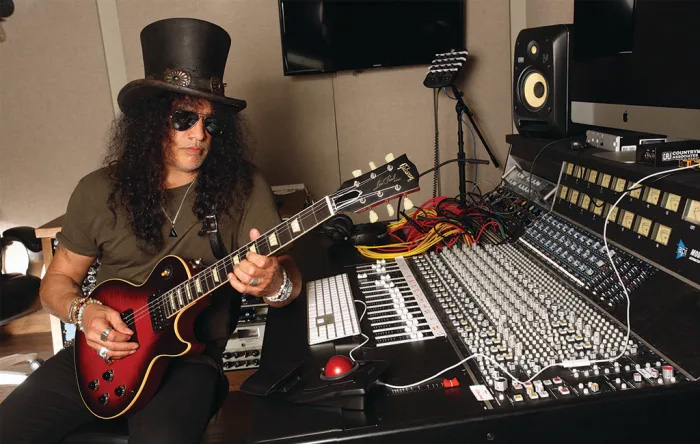
You’ve been out on the road consistently with either Guns N’ Roses or your solo band for the past several years. Do you find that you’re better suited to writing while you’re on tour, or are you more likely to compose at home or in the studio?
I do a lot of writing on the road only because that’s where I am a lot. I spend most of my time on tour, and I have a lot of time before a show or on a day off or in hotel rooms where I can just pick up a guitar and play without it really feeling like I have some sort of schedule that I have to be on. If I was to go into a recording studio and go, “I need to make a record,” that would be a deterrent to me being able to create anything. I like anywhere but the place that’s built for writing. [laughs]
That said, you recently built the Snakepit, your new recording studio in L.A. What can you tell us about it?
It’s probably the third studio I’ve built in a residence. There’s nothing super unique about it. It’s just a small house that I found that had ample space for the live room and a control room. Neither one is large, but we ended up doing all the vocals and guitars there for Living the Dream. It’s not a great drum room, so we didn’t do the drums there, but we did all the overdubs and played live in the live room. The main thing is, it’s ours. We don’t have to block out time or deal with a studio owner or anything. We can go in there and play when we want, for as long as we want. It was a little bit difficult for Elvis [Baskette, Living the Dream producer] to record the guitars and all that stuff in there, because it’s a small space. It was a little bit of trial and error, but it came out really cool.
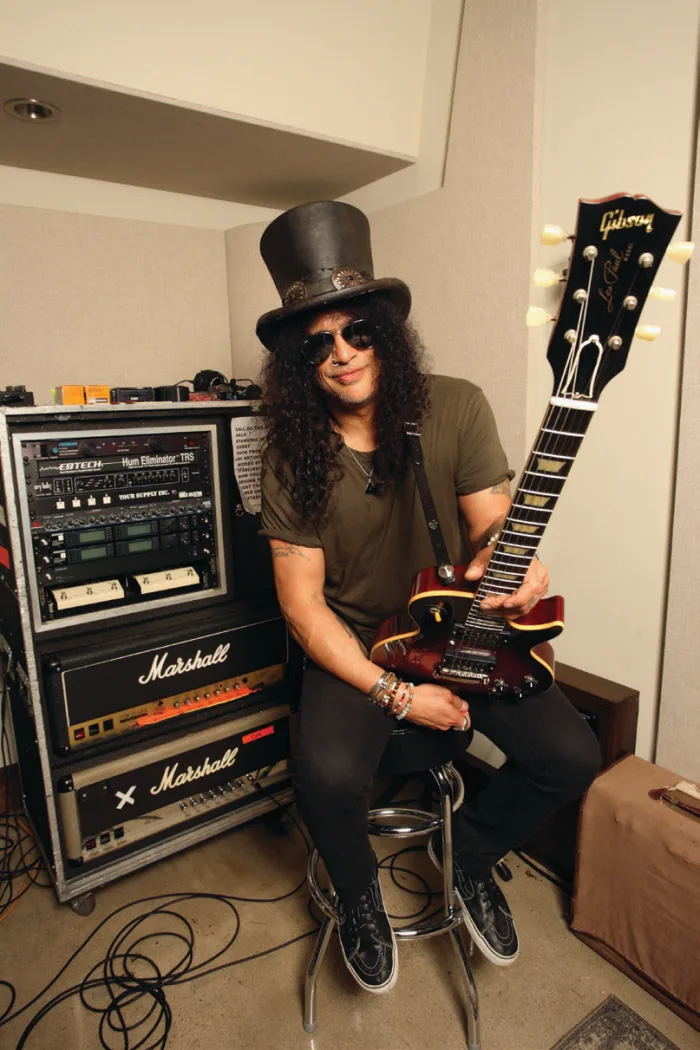
Some people use the studio to write and as a creative tool. Do you think of it that way, or is it more a place to get your ideas down on tape?
It’s definitely more of a place to get stuff done. I’ve never used the studio as a creative space, like, “Let’s go in and sit around and make up stuff.” For me, the studio is a place to be able to go in and rehearse and record.
What makes a good guitar riff?
That’s a good question! Because I’m out here now working with the guys on stuff for a new Conspirators record, and I was wondering the same thing. [laughs] I do come up with a lot of riffs. As far as the ones that work, they have something that appeals to me, whether it’s a succession of notes or a rhythm or a melody. The thing is, I can sit around and play guitar all day and sometimes not recognize a good riff. It might not catch my ear. But if I sit down and really work on it with some other people, they hear what I’m missing and say, “Oh, yeah, that’s going to be great.” But something has to grab me in the first place before I’ll be able to focus on it and pursue it as a riff.
Once you have that riff that grabs you, do you have a general approach as far as building the rest of the song and an arrangement around it?
Once you have a riff, a chord change, a little guitar piece or whatever it is that really grabs you, there’s a fair share of imagination that goes into it at that point. You start to imagine where it’s going. Usually, the only way I can really tell if it’s worth anything is to go and play it along with some drums. That’s the first thing. Ultimately, I need to hear it with bass and drums, but I’ll take the drums first, just to get an idea of the rhythm of it. And that will start to inspire where it should go.
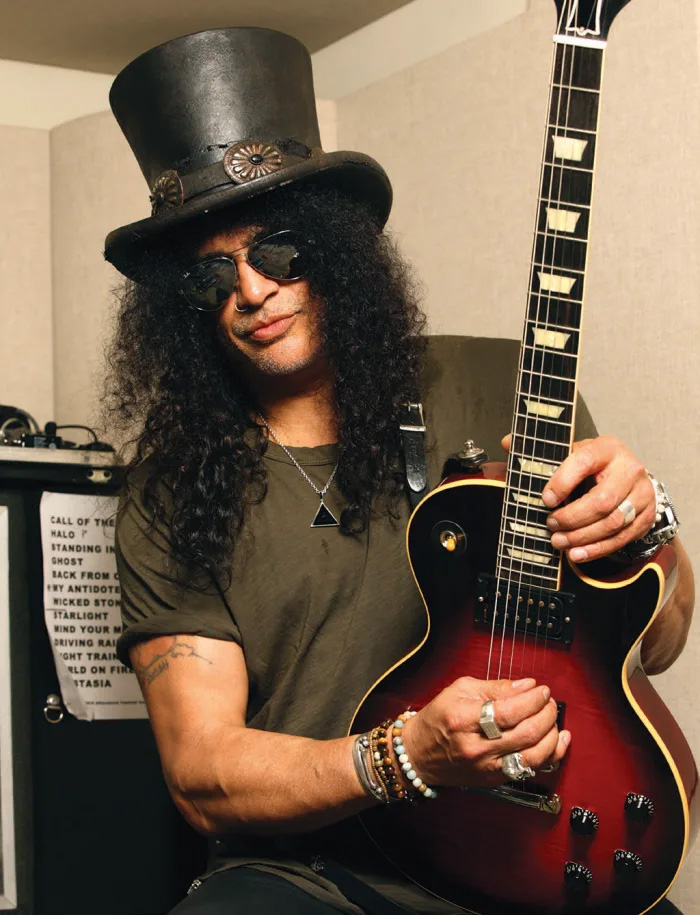
Let’s look at some songs from your career as examples. I thought we’d start with the recent single from Living the Dream, “Boulevard of Broken Hearts.” How did that one come together?
Funny enough, that was one of the few times where I sat down and actually said, “I need to write something.” There was a break from the Guns N’ Roses tour in the winter of 2018, and I used that time to put this record together. I had from Christmas until, I think, March to finish writing and then record the album. So I was sitting on the couch watching TV - I always sit around the house with a guitar - and I started coming up with that single-string picking thing on the D string. I had that little melody, and it sort of wrote itself from there. And then I brought it into rehearsal a few weeks later and started running it down with the guys. From there, the arrangement came together primarily instrumentally. After that, Myles heard it and came up with the vocal melody. So it was a very simple and quickly written song.
That single-string melody reminds me of a David Gilmour style of motif.
Probably because it’s played on the open D string and, if I remember correctly, one of songs on The Wall, whatever the name of that song is [“Run Like Hell”], had a similar kind of thing. But I wasn’t necessarily what you would call “inspired” by that.
One of the standout tracks on the new album is “The Great Pretender,” which is a more complex and intricately arranged ballad.
That one was like the flip side of “Boulevard of Broken Hearts” as far as the amount of time that went into developing it. When that first came up, it was just that opening guitar melody. I can’t even remember where I was when it came together, but it was something that started with three notes, and then it built into that whole sort of melody that is the intro. It’s really, really different than what I normally bring in to the guys, so we spent a lot of time trying to get the right vibe. It was one of those things where it’s not just a regular rock and roll song. It’s got a lot of variables in terms of the subtleties. You don’t want to be too jazzy, you don’t want to be too sing-song-y.
But the actual arrangement, the chord changes and all that, came together relatively easy. Once I got the guitar melody down, then I had the verse and I had the chorus. So it was really about just trying to get the right feel for it. And it took a little while. But on every record, there’s always that song. [laughs] There’s always that one that needs to be pieced together and somehow is more complex than every other song. “The Great Pretender” was one of those. We’re working on another one like that right now that we’ve been doing at soundcheck every gig.
“The Great Pretender” is also interesting because it’s an example of a song that came not from a riff or a chord progression but rather from a lead melody.
Yeah. But to me, riffs and chord progressions and melodies…it’s all relative. I mean, the lead line is still just a riff, you know? It’s another way of playing a riff. But I know what you mean, at least in terms of what I do. When you think of a riff, you’re thinking of something like “Welcome to the Jungle,” where you’ve got low notes and things like that. But I notice that the riffs that are prominent in all the music I grew up listening to - from the Beatles to the Stones to Clapton - there’s always a melody of some sort, which is really the hook.
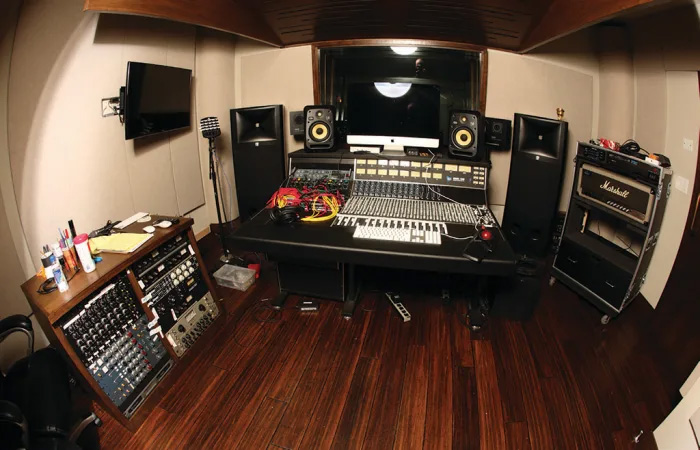
Another example of that sort of thing, where the opening hook is a melodic pattern played on the high strings, would be “Anastasia,” from the first Conspirators album, 2012’s Apocalyptic Love. It’s the “Sweet Child O’ Mine” sort of approach.
That one came together when we were touring off my 2010 [self-titled] solo record, which is when the Conspirators band formed. During that tour, I don’t know if I was doing the Godfather theme [“Speak Softly, Love”] in the shows or what, but I sort of stumbled across this melody thing during my solo section in the shows, and I remembered it and started developing it every night onstage. It was something to look forward to and to mess around with and improvise. I definitely had a thing in mind that I was hearing, and I just kept approaching it every night. And then sometimes I would go back to the dressing room or back to the hotel room and work on it. After a while, I finally got a handle on it, and that’s where “Anastasia” came from. By the time I brought it to the guys, it was complete.
I would imagine the challenge with something like that is in taking that motif, which is almost classical-sounding in nature, and fitting it into a rock song.
Yes, but the thing is it still has heavy dynamics. I thought of it as being pretty driving. So it was actually really easy to imagine how that was gonna feel. The way that we approach the rhythm of it, it’s not as subtle as something like “The Great Pretender.”
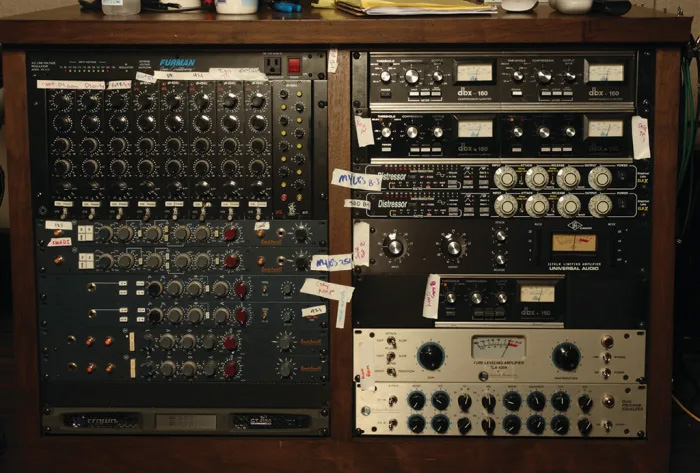
One of the few Guns N’ Roses songs you’ve been playing on the current Conspirators tour is “Rocket Queen” - which, coincidentally, also has an incredibly strong and prominent riff. How did that one come together?
I came up with that first main riff to “Rocket Queen” at my mom’s house. At that time I was working with [future Guns N’ Roses band mates] Duff and Steven [Adler] in this band called Road Crew. I brought it to them, and we started working out that riff and a couple of different parts. Then Road Crew fizzled out; we could never find a singer, and it just sort of disbanded. And a year later, or maybe even less, Guns N’ Roses came together, and I reintroduced that riff. Then Axl had this other part, which was the chorus section and was completely different from the idea of where the riff was going. We put those two together and it just made this really cool sort of contrast. And that’s basically the nuts and bolts of how that song came together.
We hear you play that type of riff, which is somewhat twisting and chromatic in nature, in other Appetite for Destruction songs, such as the verse to “Paradise City” and the intro to “Mr. Brownstone.” How does that sort of thing come together for you?
I wish I had a legitimate answer to that question. I really don’t know. There’s really no formula or procedure for it. Sometimes you just come up with a riff and move it around on the guitar. Sometimes you hear something in your head and you don’t even have a guitar on you, but it sticks around long enough until you pick up a guitar and you figure it out. There are so many different ways that things can come to you. The best thing you can do is always have a guitar close by, which is something I’ve learned to do.
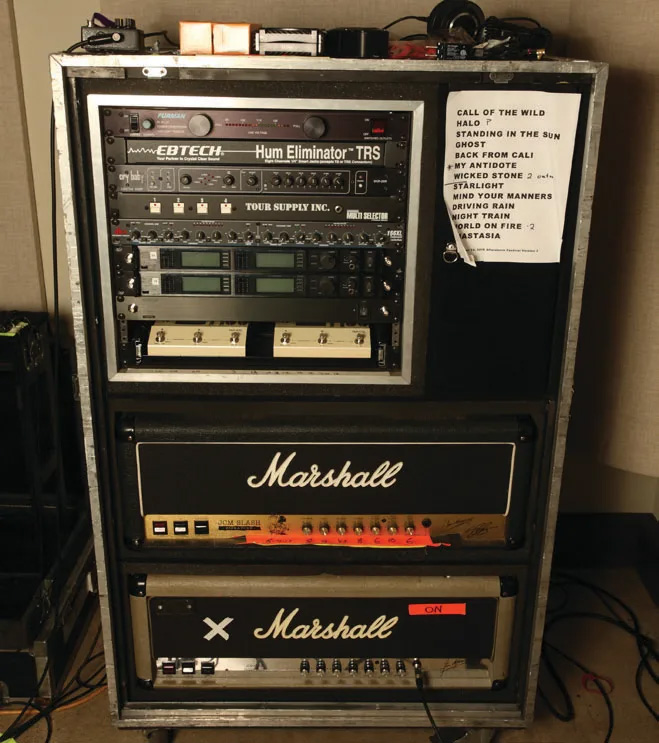
The other Appetite song you’ve been playing lately with the Conspirators is “Nightrain.” And that’s one where the main riff is really a combination of two parts - power chords on the low strings and a melodic line on the treble strings.
Well, when that song first happened, it started with Izzy [Stradlin] playing the single-note melody. And then I came up with the three-note chords that sort of mirror that and made it into a dual-guitar kind of thing. And it was a band thing from that point on. But that was really Izzy’s little melody that we embellished.
So that would be an example of a song where someone else provided the spark, but you were able to build off of it and make it into a finished composition.
Yeah. And one great thing about working with Izzy was that his approach was always very, very simple. It was a sort of primitive kind of a thing where if it caught my ear, I would be able to counter it with something that was a little bit more chunky. “Out Ta Get Me” was another one of those. I heard Izzy play that melody, and it caught my ear, and I was all over it. That’s one of the great things about Izzy - his little parts would really inspire me sometimes. And “Nightrain” was one of those kinds of things.
As far as these recent shows, is there any new gear you’ve been using onstage?
Amp-wise I’ve just been using the [Marshall] Jubilee for the past couple of years. So far, I’m not thinking about changing. As for guitars, on the last record I ended up using a ’54 [Les Paul] Goldtop with soapbar pickups for a lot of it, which was very, very different for me. But I didn’t want to take a guitar with soapbars in it out on the road, because no matter how you look at it they’re just too noisy for a Marshall on full blast.
So I’ve been using some really great reissue Les Pauls that Gibson made for me that have humbuckers, but have just enough bite to really stand out and have a great attack and sound good. One is the Slash Brazilian Dream Les Paul, which has a strange sort of tobacco finish, and the other one is a red Slash Vermillion Les Paul. They’re both really, really cool.
You mentioned you’re working on new Conspirators music. What’s the status of that?
I’m using this time when we’re on the road to accumulate as much material with Myles and the band as possible. Because after this tour’s over I go back to working on Guns. So I come up with stuff here and there and jam it with the band at soundcheck to get the idea of where it’s headed, and then we get it down on tape. And at some point where there’s a window in the Guns’ schedule, we’ll get together and record it. There’s some really good material for this next one, whenever we get around to doing it. So I’m really excited.
What about Guns N’ Roses - any new music in the works?
We finally started working toward getting some material recorded. We get back together in October and go out on the road, and then as soon as that’s over, we’ll hunker down and start moving toward getting a record done.
And when do you think we might hear that record?
I have no idea at what pace that will happen. [laughs] With Guns N’ Roses it’s best not to speculate. You just do it when it’s gotta be done.
Get The Pick Newsletter
All the latest guitar news, interviews, lessons, reviews, deals and more, direct to your inbox!
Rich is the co-author of the best-selling Nöthin' But a Good Time: The Uncensored History of the '80s Hard Rock Explosion. He is also a recording and performing musician, and a former editor of Guitar World magazine and executive editor of Guitar Aficionado magazine. He has authored several additional books, among them Kurt Cobain: Montage of Heck, the companion to the documentary of the same name.
“We’d heard Jimi Hendrix, we'd heard the Who, but now we finally got to see these guys. And watching Jimi Hendrix burn his guitar….” Grace Slick on Hendrix at Monterey, Jefferson Airplane and the Spanish origins of “White Rabbit”
“I’m still playing but I’m covered in blood. Billy’s looking at me like, ‘Yeah! That’s punk rock!'” Steve Stevens on his all-time worst gig with Billy Idol — and the visit to Jimi Hendrix's grave that never happened
